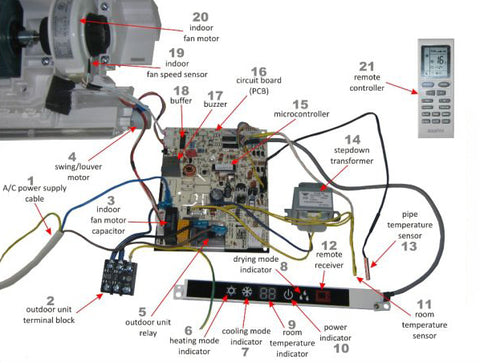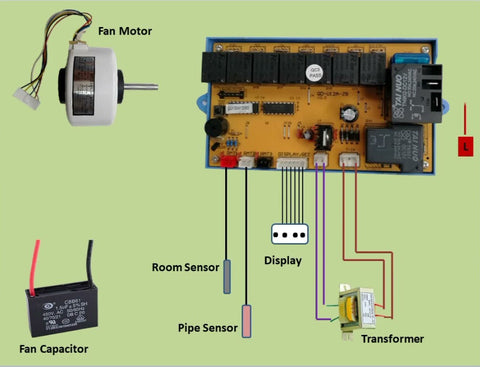What is an AC Control Board?
An AC control board, or furnace control board, is essentially the brain of an HVAC system. The control board plays a pivotal role in controlling and coordinating all the individual components of the HVAC system, such as the blower motor, compressor, and heating element. It also interacts with safety devices to prevent dangerous situations or equipment damage. Additionally, the control board uses input from the thermostat and other sensors to adjust the operation of the HVAC system, ensuring that the indoor climate remains comfortable and consistent. It is also crucial for maintaining energy efficiency, troubleshooting, and integrating the system with modern technologies like home automation.
Inside an AC Control Board
The basic components typically found on an AC control board are:
-
Microprocessor or Microcontroller: This is the 'brain' of the control board. It's a small computer that receives input from the various sensors in the AC system and uses programmed instructions to control the operation of the AC system.
-
Power Supply Circuit: This provides the necessary power for the operation of the control board and the components it controls. It often includes AC (alternating current) and DC (direct current) power circuits.
-
Relays or Triacs: These are switches controlled by the microprocessor that turn on and off different parts of the AC system, such as the fan motor, compressor, etc.
-
Thermostat Connection: This allows the control board to receive input from the thermostat, which sets the desired temperature.
-
Fault LED Indicators or Display: These visually indicate system status and fault conditions.
-
Sensors Input: Inputs from various sensors in the system, like temperature sensors, pressure sensors, humidity sensors, etc., are used by the microcontroller to make decisions and control the operation of the AC system.
-
Safety Devices: The control board often has inputs from safety devices like high-pressure switches, flame sensors, and limit switches. If any of these safety devices signal a problem, the control board will shut down the appropriate part of the system to prevent damage or dangerous conditions.
-
Communication Ports: Some modern AC control boards include communication ports for integration with home automation systems or for connection to diagnostic tools.
-
Capacitors and Resistors: These basic electronic components help control the circuit's electricity flow and voltage levels.
-
EEPROM (Electrically Erasable Programmable Read-Only Memory): This memory chip stores the firmware, the microcontroller's software, to control the AC system.

The exact components and their arrangement can vary between different models and manufacturers of AC control boards.
How Does an AC Control Board Work?
The AC control board orchestrates and oversees the various components of an HVAC system through a sequence of interactions and feedback loops involving sensors, electronic components, and HVAC equipment.
The control board is primarily driven by a microprocessor or microcontroller – a small computer programmed with the necessary instructions to control the HVAC system. It receives inputs from various sensors installed throughout the system, such as temperature, pressure, and humidity sensors, as well as inputs from the thermostat which sets the desired temperature.
The microcontroller then processes these inputs, making decisions based on the received data. For instance, if the thermostat is set to a cooler temperature and the indoor temperature sensor signals that the room is too warm, the control board will activate the cooling cycle. This typically involves starting the blower fan and compressor and possibly opening or closing various dampers.

The control board uses components like relays to control these different parts of the system. These are essentially electronically controlled switches that can turn parts of the HVAC system on and off based on the instructions from the microcontroller.
Simultaneously, the control board is also in constant communication with safety devices like high-pressure switches, flame sensors, and limit switches. If any of these devices signal a problem, the control board can promptly shut down the relevant part of the system or the entire system to prevent damage or dangerous conditions.
Besides these basic operations, AC control boards often come with advanced features, such as displaying diagnostic codes or connecting to home automation systems.
AC Control Board Maintenance & Troubleshooting
Common AC Control Board Problems
AC control boards can encounter a variety of problems that may prevent your HVAC system from functioning properly. Here are some common issues:
-
Faulty Relays: The relays on the control board are responsible for sending power to different HVAC system components, such as the compressor or fan motor. A faulty relay may not send the necessary power, causing the corresponding component to malfunction.
-
Burnt or Damaged Components: Over time, electrical components on the control board can become burnt or damaged due to heat, voltage spikes, or wear and tear. This could affect the board's ability to control the HVAC system effectively.
-
Bad Capacitors or Resistors: Capacitors and resistors regulate the flow of electricity through the circuit. If they're not working correctly, they could disrupt the power supply and cause the control board to malfunction.
-
Software Glitches: Since the control board relies on firmware to operate, software glitches can occur, causing the system to act erratically or not at all. Sometimes, these issues can be fixed with a firmware update.
-
Corrosion: If moisture gets into the control board, it can cause corrosion, damaging the electrical connections and causing the board to malfunction.
-
Poor Connections: Over time, connections between the control board and other parts of the HVAC system can become loose or corroded, interrupting the communication between the board and the system.
-
Power Supply Issues: Problems with the power supply circuit on the control board can lead to various issues, such as the HVAC system not turning on or components not receiving the right amount of power.
AC Control Board Replacement
Replacing an AC control board is a task that requires some technical knowledge. If you're unfamiliar with the process, hiring a professional HVAC technician is usually best. However, if you're comfortable with HVAC systems and electrical components, you can do it yourself. Here are the general steps:
- Safety First: Turn off all power to your HVAC system at the circuit breaker to avoid any electrical shock hazard.
- Access the Control Board: Open the HVAC unit using the appropriate tools (usually a screwdriver). The location of the control board will vary depending on your specific HVAC system model.
- Identify and Record Connections: Before disconnecting anything, take pictures or note where all the wires are connected to make reassembly easier.
- Remove the Old Control Board: Carefully disconnect the wiring from the old control board. Depending on how the wires are connected, you may need to use a screwdriver or pliers. Once all the wires are disconnected, remove the old board from the unit.
- Install the New Control Board: Mount the new control board in the same spot as the old one. Carefully reconnect the wires to the new board, using your notes or pictures as a guide.
- Close the Unit and Restore Power: Once everything is reconnected, close the HVAC unit and restore power at the circuit breaker. Test the system to ensure everything is working correctly.
AC Control Board FAQs
Where is the AC control board located on a commercial AC?
The location of the AC control board in a commercial HVAC system can vary based on the specific model and manufacturer. However, it's typically found inside the indoor air handler or furnace compartment, mounted on a panel. It's usually near the blower motor since it directly controls this component. Since the control board is an electronic component, it is often enclosed in a protective casing to protect it from dust, debris, and moisture.
How do I test an AC control board?
Before starting, ensure that all power to the HVAC system is turned off at the circuit breaker. Open the HVAC unit and locate the control board. It is usually located in the air handler or furnace compartment. Check the control board for any signs of damage, such as burnt components, corrosion, or loose connections.With the power back on, use a multimeter to check if the board is receiving power. Measure the voltage between the R and C terminals – it should be around 24 volts for most systems. If there's no power, there might be a problem with the transformer or wiring. You can also check if the control board is sending power to the HVAC components. Measure the voltage from the control board to the components (e.g., the blower motor, compressor) when they're supposed to be operating. If there's no voltage, the control board might be faulty.Many control boards have an LED that flashes a specific pattern when there's a problem. Refer to your system's manual to interpret any flashing patterns.
How do I know if my AC board is bad?
Identifying a bad or malfunctioning AC control board can be challenging because the symptoms can sometimes resemble other HVAC issues. However, here are some signs that your AC control board might be failing:
- HVAC System Does Not Respond to Thermostat: If you adjust the settings on your thermostat and your HVAC system doesn't respond or doesn't maintain the desired temperature, it might be due to a faulty control board.
- HVAC System Randomly Starts or Stops: If your HVAC system randomly starts or stops even when the thermostat settings have not been changed, it could be a sign that the control board is malfunctioning.
- Certain Components Not Operating: The control board regulates the operation of various HVAC components. If a specific component, like the blower motor or the compressor, is not functioning even when it should be, the control board might be at fault.
- Frequent On and Off Cycling: If the HVAC system turns on and off more frequently than normal, it could be due to a control board issue.
- Visible Damage or Error Codes: A visual inspection might reveal burnt or corroded components on the control board. Also, many control boards have an LED light that flashes specific patterns to indicate an error code. Refer to your system's manual to interpret these codes.
Control Boards by Manufacturer
Carrier Control Boards
Carrier control boards and modules are the central control unit for HVAC systems, ensuring seamless coordination and efficient operation. These boards monitor and regulate various system functions, including temperature control, fan speed, and diagnostics. Carrier control boards optimize energy usage, provide reliable control over system operations, and enhance overall performance.
Trane Control Boards
Trane control boards are the central control units for Trane HVAC systems, overseeing and regulating system functions. These boards monitor temperature, airflow, and system diagnostics to ensure efficient operation.
Daikin Control Boards
Daikin control boards act as the main control units for Daikin HVAC systems. They oversee and regulate multiple system functions, such as temperature control, airflow, and system diagnostics. Daikin control boards guarantee smooth coordination and efficient operation, optimizing energy usage and enhancing the overall performance of the system.
AAON Control Boards
AAON control boards oversee HVAC system operations, coordinating and controlling functions. They ensure an efficient response to thermostat demands and environmental changes.
Johnson Controls Control Boards
Johnson Controls control boards coordinate HVAC system components, ensuring efficient and reliable operation in response to thermostat commands and environmental stimuli.
Shop Johnson Controls Control Boards
Lennox Control Boards
These control boards serve as the core of Lennox's HVAC systems, overseeing and managing system performance. Their advanced design and functionality improve system responsiveness, reliability, and energy efficiency.
York Control Boards
York control boards serve as the core of a York HVAC system, overseeing and managing the operation of various system components. With their expertise, York control boardss guarantee the seamless and effective functioning of the system, enabling it to accurately adapt to thermostat settings and environmental factors.

